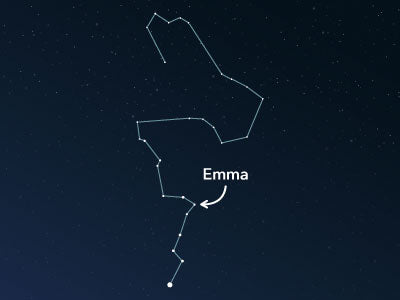The constellation Eridanus
Characteristics
- Hemisphere
- Both Hemispheres
- Visibility
- October - February
- Area
- 1138 deg²
- Brightest star
- Achernar (HIP number 7588)
- Specialties
- Galaxies, planetary nebula, reflection nebula

The constellation Eridanus is one of the 48 constellations determined by the Greco-Roman astronomer Claudius Ptolemy in ancient times. It is a vast constellation but not very prominent. There are some interesting nebulous objects located in this celestial area. However, they can only be observed with professional equipment.
Hemisphere, visibility, and area
The constellation stretches from the south up to just above the equator, making it fully visible from the southern hemisphere and visible up to the 33rd parallel in the north. This corresponds roughly to regions such as the north of Shanghai in China, Casablanca in Morocco, or San Diego in the US.
October through February offer the best opportunity to observe Eridanus in the night sky.
It is a very expansive constellation, covering an area of approximately 1,138 square degrees. In comparison with all other 88 constellations, it ranks 6th in size. In visualizations, Eridanus is depicted as a long chain of stars.
Despite its size, it is rather inconspicuous and can be easily overlooked. That is because Eridanus consists mainly of faint stars, with only four stars brighter than the third magnitude.
The brightest star, with an apparent magnitude of 0.45, is Achernar (Latin: α Eridani, Alpha Eridani). It is the ninth brightest star in the night sky and is not visible from northern regions such as Central Europe, Canada, or the US due to its southern location. Achernar is a double-star system located approximately 139 light-years away from earth.
Eridanus borders many other constellations, including unknown ones such as the Caelum and the Lepus, as well as famous constellations such as Orion to the south and Taurus to the north. Other neighbors include the Cetus, the Fornax, and Phoenix. The Hydrus and the Horologium also border Eridanus.
Specialties in the constellation
The constellation contains several inconspicuous deep-sky objects, such as various galaxies, as well as planetary and reflection nebulae.
Among them is the elliptical giant galaxy NGC 1132, which is very rare. It has a diameter of approximately 230,000 light-years and is located about 310 million light-years away from the Milky Way.
Another special object is the barred spiral galaxy NGC 1291 (also NGC 1269). It is the brightest galaxy in Eridanus and about 32 million light-years away from the Milky Way.
A planetary nebula also lies in the constellation. The NGC 1535 is located at about 5,000 to 6,000 light-years and can be observed with a larger telescope. On photographic images, it appears as a blue-turquoise-grey nebulous patch.
Mythology
In Greek mythology, Eridanus represents a river that originates from the waters of Aquarius and into which the dead Phaeton fell. Phaeton is the son of the sun god Helios. According to legend, a catastrophe occurred when he took over his father's sun chariot.
Phaeton drives the chariot, which carries the sun across the sky, and loses control. Eventually, he gets too close to the earth, causing the northern part of Africa to be burned and the skin of the people living there to turn dark.
Zeus, the most powerful of all Greek gods, is angry about this act and kills Phaeton with a lightning bolt.
Originally, the constellation Eridanus represented Phaeton's journey with the chariot. Later, the interpretation changed, and the constellation stood for the river into which the dead Phaeton fell.
PublishedRead more interesting articles

An overview of all 88 constellations
Learn more about all 88 constellations and read interesting information about the mythology, visibility, and features.

Planetarium App
Discover the night sky with our planetarium app!
Available for iOS and Android.

Name a star in the constellation Eridanus
Name a star in a constellation and create something that lasts for eternity.